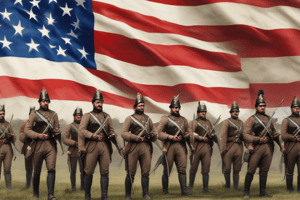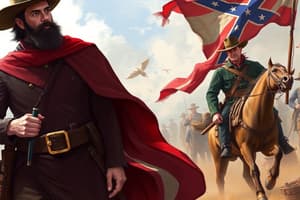Podcast
Questions and Answers
Which factor most influenced the initial secession of Southern states from the Union?
Which factor most influenced the initial secession of Southern states from the Union?
- The Confederate States' superior industrial capacity threatened the Union's economy.
- Federal mandates requiring immediate emancipation of all enslaved people in Southern states.
- Widespread economic depression in the South due to reliance on a single cash crop.
- The election of Abraham Lincoln, which was perceived as a threat to Southern interests. (correct)
Why was the location of Fort Sumter strategically important to both the Union and the Confederacy?
Why was the location of Fort Sumter strategically important to both the Union and the Confederacy?
- It was situated in Charleston Harbor, a crucial Southern port. (correct)
- It was a major transportation hub for the railway network.
- It controlled access to key agricultural resources.
- It was the only military installation in the region.
How did Lincoln address the potential secession of border states, and why was this significant for the Union?
How did Lincoln address the potential secession of border states, and why was this significant for the Union?
- He ignored them, believing that they would eventually remain in the Union willingly.
- He negotiated compromises on slavery, because maintaining national unity was his primary concern.
- He offered economic incentives, because their economies were critical to the Union's war effort.
- He imposed martial law, because losing them would have strategic implications, such as the potential encirclement of Washington D.C. (correct)
What was a significant advantage of the Union over the Confederacy at the beginning of the Civil War?
What was a significant advantage of the Union over the Confederacy at the beginning of the Civil War?
How did the Confederate States of America justify their secession from the Union?
How did the Confederate States of America justify their secession from the Union?
What was the primary economic challenge faced by the Confederacy at the start of the Civil War?
What was the primary economic challenge faced by the Confederacy at the start of the Civil War?
What was the main purpose of the Legal Tender Act passed by Congress during the Civil War?
What was the main purpose of the Legal Tender Act passed by Congress during the Civil War?
Why did President Lincoln suspend habeas corpus during the Civil War?
Why did President Lincoln suspend habeas corpus during the Civil War?
How did the Union's strategy of blockading Southern ports impact the Confederacy's ability to sustain the war effort?
How did the Union's strategy of blockading Southern ports impact the Confederacy's ability to sustain the war effort?
What was the significance of the Battle of Antietam?
What was the significance of the Battle of Antietam?
What was the Anaconda Plan designed to achieve?
What was the Anaconda Plan designed to achieve?
What was the initial aim of the Civil War according to President Lincoln, before the Emancipation Proclamation?
What was the initial aim of the Civil War according to President Lincoln, before the Emancipation Proclamation?
What was the 'Trent Affair' during the Civil War, and why was it significant?
What was the 'Trent Affair' during the Civil War, and why was it significant?
In what way did the First Battle of Bull Run impact the initial strategies and expectations of both the Union and the Confederacy?
In what way did the First Battle of Bull Run impact the initial strategies and expectations of both the Union and the Confederacy?
What was the strategic significance of the Union victory at the Battle of Shiloh?
What was the strategic significance of the Union victory at the Battle of Shiloh?
Flashcards
Secession
Secession
Withdrawal from the United States
Confederate States of America
Confederate States of America
The nation formed by seceding Southern states.
Fort Sumter
Fort Sumter
Union fort attacked, marking the start of the Civil War.
Martial Law
Martial Law
Signup and view all the flashcards
Union (North) Advantages
Union (North) Advantages
Signup and view all the flashcards
"Greenbacks"
"Greenbacks"
Signup and view all the flashcards
Habeas Corpus
Habeas Corpus
Signup and view all the flashcards
Blockade Runners
Blockade Runners
Signup and view all the flashcards
War of Attrition
War of Attrition
Signup and view all the flashcards
Anaconda Plan
Anaconda Plan
Signup and view all the flashcards
"Stonewall" Jackson
"Stonewall" Jackson
Signup and view all the flashcards
Battle of Shiloh
Battle of Shiloh
Signup and view all the flashcards
Battle of Antietam
Battle of Antietam
Signup and view all the flashcards
Emancipation Proclamation
Emancipation Proclamation
Signup and view all the flashcards
Conscription
Conscription
Signup and view all the flashcards
Study Notes
- After Lincoln's election, Southern states seceded, fearing threats to their way of life.
- South Carolina was the first to secede, followed by Mississippi, Florida, Alabama, Georgia, Louisiana, and Texas.
- Seceding states formed the Confederate States of America with a constitution mirroring the U.S. one.
- Jefferson Davis was elected president of the Confederacy.
- The Confederacy seized federal assets without returning them.
Fort Sumter
- Fort Sumter, a Union fort in Charleston Harbor, was strategically vital.
- Confederate forces bombarded Fort Sumter for 33 hours, leading to its surrender and marking the start of the Civil War.
Choosing Sides
- The Upper South was initially hesitant to secede.
- Virginia, Arkansas, North Carolina, and Tennessee joined the Confederacy after the war began.
- Lincoln imposed martial law in border states to prevent further secession, fearing Washington D.C.'s vulnerability.
- Martial law involved military control, replacing civilian authorities and suspending civil rights.
Union (North) vs. Confederacy (South)
- The Union had a population of 22 million, while the Confederacy had 9 million (including 1/3 enslaved).
- The Union's economy was industrialized, boasting 90% of the nation's factories and a superior railway network and navy.
- The Confederacy's economy was agricultural, producing only 5% of the U.S.'s iron with a smaller railway network.
- The Union's leader was Abraham Lincoln, and its general was Winfield Scott.
- The Confederacy's leader was Jefferson Davis, and its general was Robert E. Lee.
War Finances
- There were concerns about the North's ability to finance the war, leading to gold and silver withdrawals from banks.
- Congress passed the Legal Tender Act, creating the first national currency, nicknamed "Greenbacks".
Northern Politics
- The North was politically divided
- Some Republicans advocated for abolishing slavery while others wanted to prevent its expansion.
- Democrats were split between those favoring war and those seeking peaceful negotiations.
- Republicans often viewed Democrats as traitors, calling them "Copperheads."
Suspension of Habeas Corpus
- The North implemented conscription to bolster troop numbers, which sparked riots among Northern Democrats.
- Lincoln suspended habeas corpus to enforce conscription and maintain peace.
- Habeas corpus protects individuals from imprisonment without being charged with a crime and put on trial.
- Lincoln's suspension allowed indefinite imprisonment without trial for those supporting the Confederacy or resisting the Union draft.
Blockading the South
- The Confederacy struggled financially due to its reliance on trade with Europe.
- The Union's superior navy blockaded Southern ports to cut off trade.
- Some Confederate ships, known as blockade runners, evaded the blockade at night, but trade was significantly reduced.
Trent Affair
- The Confederacy sought recognition and military aid from European countries.
- Confederate representatives were sent to Britain and France aboard the British ship Trent.
- The Union intercepted the Trent, angering the British and leading to threats of war.
- An unofficial motto was established by both sides, "One war at a time".
War of Attrition
- Technologies defined the Civil War, resulting in high casualties on both sides.
- Attrition, wearing down the enemy through resource and soldier exhaustion, became a key strategy.
Anaconda Plan
- Winfield Scott proposed the Anaconda Plan for Union victory.
- The plan involved blockading Confederate ports and controlling the Mississippi River.
- The strategy aimed to gradually weaken the South, minimizing casualties but requiring a long time.
First Battle of Bull Run
- Confederate troops were stationed less than 25 miles from Washington, D.C.
- The battle initially favored the Union.
- Confederate reinforcements, led by Thomas Jackson, pushed back the Union troops.
- Thomas Jackson earned the nickname "Stonewall" for his steadfast defense.
- Following the Union loss, Lincoln called for 500,000 more troops.
Battle of Shiloh
- General Ulysses S. Grant aimed to advance into northern Mississippi after victories in Tennessee.
- Grant's troops were ambushed at Shiloh church in Tennessee.
- Grant rallied his troops and pushed back the Confederates.
- Grant launched an offensive, forcing a Confederate retreat.
- The Battle of Shiloh became the deadliest battle of the war, resulting in 20,000 casualties.
Second Battle of Bull Run
- Union defeats in Virginia forced them to retreat.
- General Robert E. Lee attacked the troops defending Washington D.C.
- Confederate forces defeated the Union at Bull Run for the second time.
- The victory opened the way for a Confederate invasion of the North.
Battle of Antietam
- Confederate forces attacked the North, with Robert E. Lee marching into Maryland.
- The Union intercepted Lee's troops, leading to the bloodiest single-day battle of the war, with 6,000 killed and 16,000 wounded.
- Lee retreated due to the heavy losses.
- This Union victory prevented British intervention and prompted Lincoln to consider ending slavery.
Road to Emancipation
- Initially, the war was focused on preserving the Union, with divided opinions on ending slavery.
- Lincoln changed his stance due to mounting Northern casualties, aiming to punish the South.
Emancipation Proclamation
- The Emancipation Proclamation was issued in September 1862.
- It declared that all enslaved people in states still in rebellion after the new year would be freed.
- The Proclamation did not apply to border states.
- The war's objective shifted from preserving the Union to liberating enslaved people.
Studying That Suits You
Use AI to generate personalized quizzes and flashcards to suit your learning preferences.




